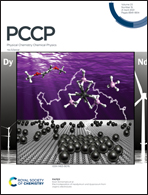Challenges for density functional theory: calculation of CO adsorption on electrocatalytically relevant metals†
Abstract
Density Functional Theory (DFT) is currently the most tractable choice of theoretical model used to understand the mechanistic pathways for electrocatalytic processes such as CO2 or CO reduction. Here, we assess the performance of two DFT functionals designed specifically to describe surface interactions, RTPSS and RPBE, as well as two popular meta-GGA functionals, SCAN and B97M-rV, that have not been a priori optimized for better interfacial properties. We assess all four functionals against available experimental data for prediction of bulk and bare surface properties on four electrocatalytically relevant metals, Au, Ag, Cu, and Pt, and for binding CO to surfaces of these metals. To partially mitigate issues such as thermal and anharmonic corrections associated with comparing computations with experiments, molecular benchmarks against high level quantum chemistry are reported for CO complexes with Au, Ag, Cu and Pt atoms, as well as the CO–water complex and the water dimer. Overall, we find that the surface modified RPBE functional performs reliably for many of the benchmarks examined here, and the meta-GGA functionals also show promising results. Specifically B97M-rV predicts the correct site preference for CO binding on Ag and Au (the only functional tested here to do so), while RTPSS performs well for surface relaxations and binding of CO on Pt and Cu.



 Please wait while we load your content...
Please wait while we load your content...